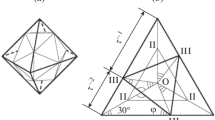Abstract
In nature, helical structures arise when identical structural subunits combine sequentially, the orientational and translational relation between each unit and its predecessor remaining constant. A helical structure is thus generated by the repeated action of a screw transformation acting on a subunit. A plane hexagonal lattice wrapped round a cylinder provides a useful starting point for describing the helical conformations of protein molecules, for investigating the geometrical properties of carbon nanotubes, and for certain types of dense packings of equal spheres.
Similar content being viewed by others
REFERENCES
Sadoc J. F.; Rivier, N. Eur. Phys. J. 1999, B12, 309.
Boerdijk, A. H. Philips Res. Rept. 1952, 7, 303.
Coxeter, H. S. M. Introduction to Geometry 1st edn.; Wiley: New York, 1961.
Coxeter, H. S. M. Regular Polytopes; Macmillan: New York, 1948 (Dover: 1973).
Coxeter, H. S. M. Can. Math. Bull. 1985, 28, 385.
Lehninger, L.; Nelson D. L.; Cox, M. M. Principles of Biochemistry; Worth: New York, 1993.
Buckminster Fuller, R. Synergetics; Macmillan: New York, 1975.
Iijima, S. Nature (London) 1991, 354, 56.
Tanaka, K.; Yamabe, T.; Fukui K., Eds., The Science and Technology of Carbon Nanotubes; Elsevier: New York, 2000.
Sadoc, J. F.; Mosseri, R. Frustration Géometrique; Eyroles: Paris, 1997; Geometrical Frustration; Cambridge University Press: Cambridge, 1999.
Lord, E. A.; Ranganathan, S. Euro. Phys. J. 2002, 15, 335.
Mackay, A. L.; Terrones, H. Phil. Trans. Roy. Soc. London A 1993, 343, 113.
Terrones, H.; Mackay, A. L. Chem. Phys. Lett. 1993, 207, 45.
Terrones, H.; Terrones, M. Fullerene Sci. Technol. 1996, 4, 517.
Terrones, H.; Terrones, M. Phys. Rev. B 1997, 55, 9969.
Hyde, S. T.; Andersson, S.; Blum, Z.; Lidin, S.; Larsson, K.; Landt, T.; Ninham, B. W. The Language of Shape; Elsevier Science: Amsterdam, 1997.
Hyde S. T.; Ramsden, S. In Mathematical Chemistry D. Bonchev and D. Rouvray, Eds.; Gordon and Breach, New York, 2000; Vol. 6, Chap. 2.
Hyde, S. T.; Oguey, C. Eur. Phys. J. 2000, B16, 613.
Stone, A. J.; Wales, D. J. Chem. Phys. Lett. 1986, 128, 501.
Pearce, P. Structure in Nature is a Strategy for Design; MIT Press: Cambridge, MA, 1978.
Walter, A. Hyperspace 2000, 9, 22.
Brakke, K. A. Exp. Math. 1992, 1, 141.
Author information
Authors and Affiliations
Rights and permissions
About this article
Cite this article
Lord, E.A. Helical Structures: The Geometry of Protein Helices and Nanotubes. Structural Chemistry 13, 305–314 (2002). https://doi.org/10.1023/A:1015863923728
Issue Date:
DOI: https://doi.org/10.1023/A:1015863923728




